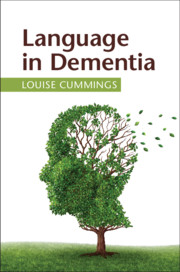
-
Select format
-
- Publisher:
- Cambridge University Press
- Publication date:
- September 2020
- October 2020
- ISBN:
- 9781108587921
- 9781108476317
- 9781108700184
- Dimensions:
- (228 x 152 mm)
- Weight & Pages:
- 0.66kg, 356 Pages
- Dimensions:
- (228 x 152 mm)
- Weight & Pages:
- 0.53kg, 356 Pages
You may already have access via personal or institutional login
Book description
Dementia is a devastating condition, with profound cognitive changes affecting every aspect of an individual's functioning. The loss of communication is one symptom above others that causes distress and impacts negatively on quality of life, yet it is still one of the least understood aspects of dementia. This book undertakes a comprehensive examination of language and communication in individuals with cognitive impairment and dementia. Each chapter covers a specific neurodegenerative disorder, and addresses the epidemiology, aetiology, pathophysiology, prognosis and clinical features, along with the assessment and treatment of these disorders by speech-language pathologists. Many examples of language from individuals with neurodegenerative conditions are included, to explain clearly the effects of dementia on communication, and there are exercises at the end of each chapter, to develop language analysis skills. The book is suitable reading for all medical and health professionals, including speech-language pathologists, clinical psychologists and neuropsychologists, geriatricians, neurologists and psychiatrists.
Reviews
‘Cummings constructed the chapters to be reference-like and clinically informative, including sections on epidemiology, etiology, pathophysiology, clinical features, prognosis, language-communication profile, phonology, morphology and syntax, vocabulary and semantics, and speech-language pathology-and each chapter includes suggested readings and exercises. Notably, the sequence of elements is intuitive and invites readers to move effortlessly between the separate diagnoses … Recommended.’
L. R. Barley Source: Choice
Contents
Metrics
Altmetric attention score
Full text views
Full text views help Loading metrics...
Loading metrics...
* Views captured on Cambridge Core between #date#. This data will be updated every 24 hours.
Usage data cannot currently be displayed.
Accessibility standard: Unknown
Why this information is here
This section outlines the accessibility features of this content - including support for screen readers, full keyboard navigation and high-contrast display options. This may not be relevant for you.
Accessibility Information
Accessibility compliance for the PDF of this book is currently unknown and may be updated in the future.


